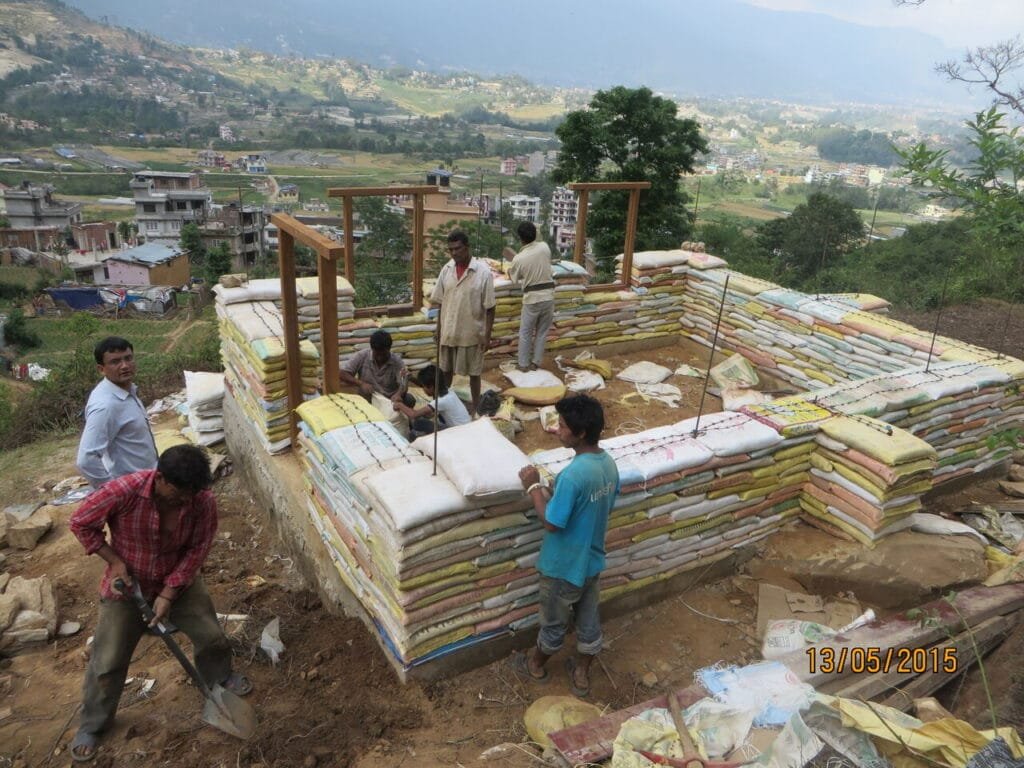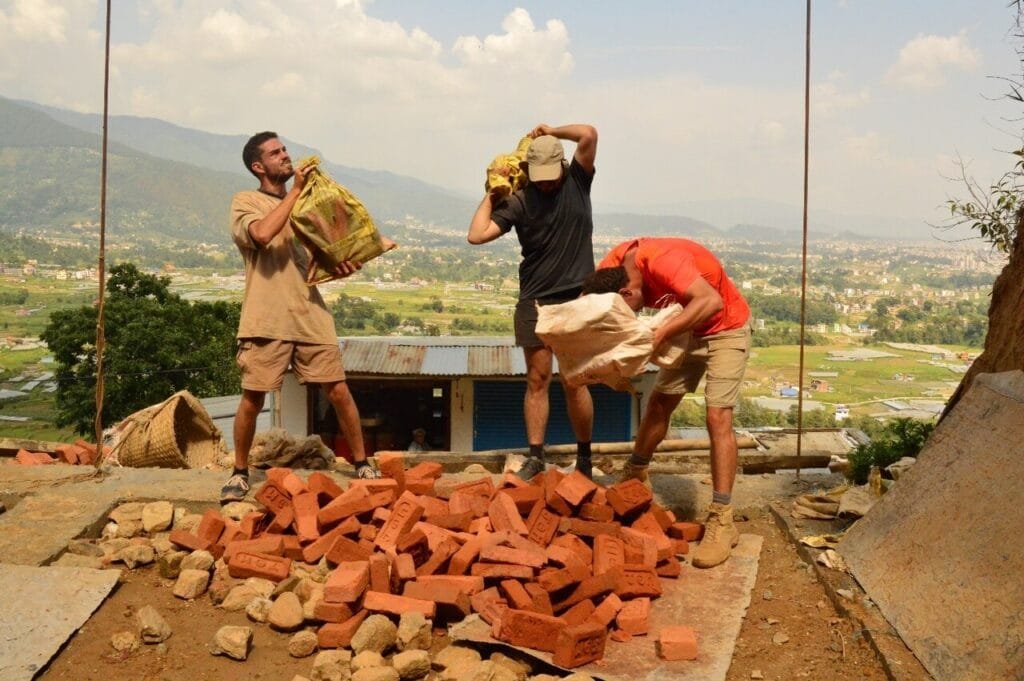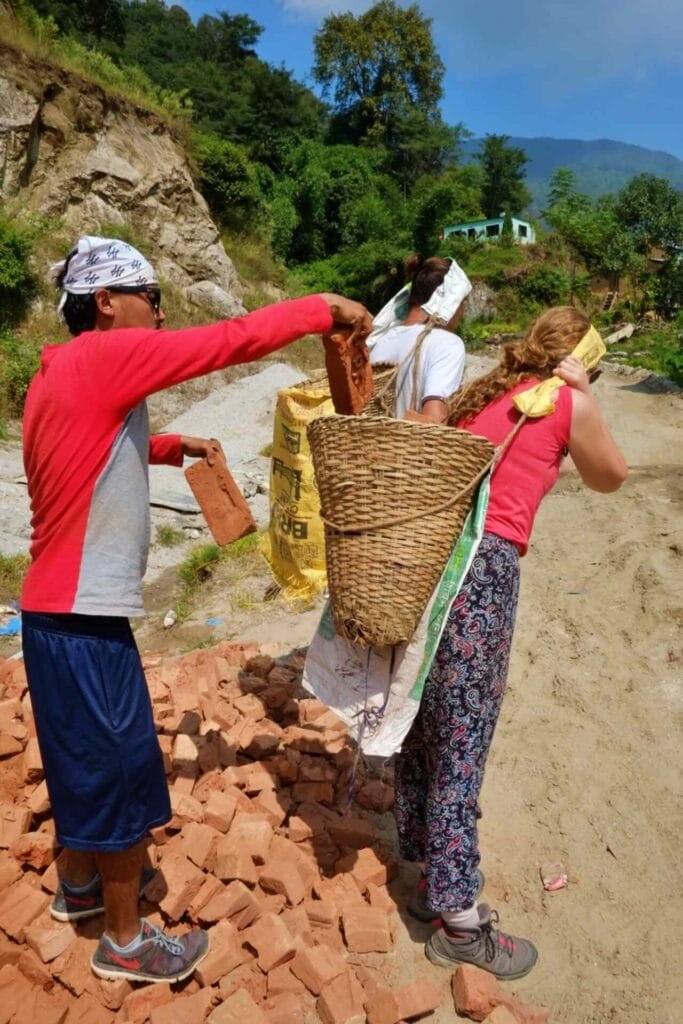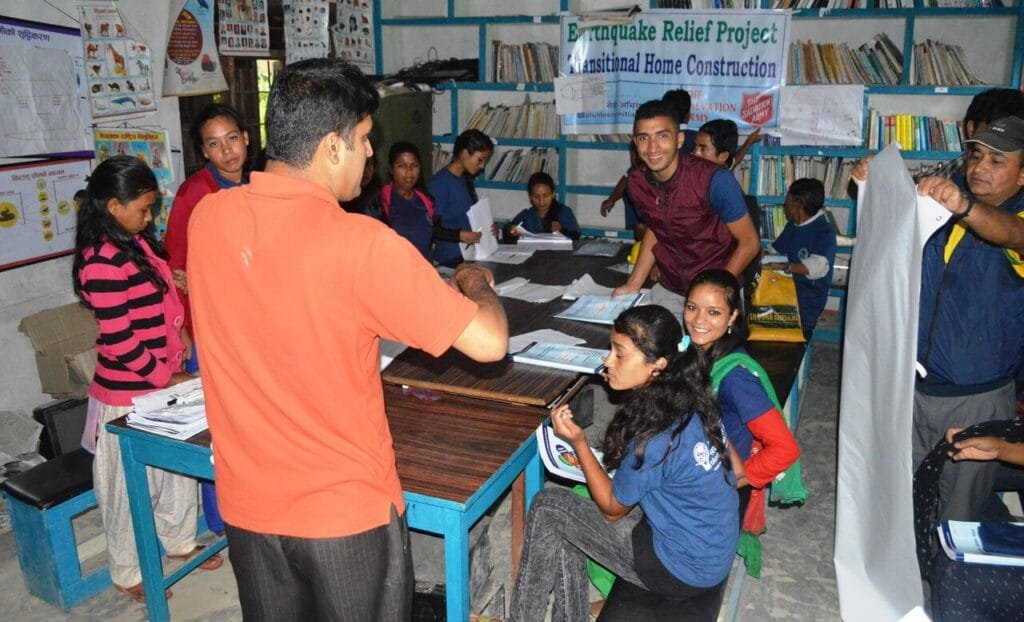Are you looking to make a profound impact while immersing yourself in the vibrant culture of Nepal? Consider becoming a Disaster Risk Management Volunteer in Nepal. By joining our program, you will actively prepare local communities for natural hazards and emergencies. As a Nepal Disaster Volunteer, you contribute directly to safer living conditions, increased resiliency, and effective crisis response. Whether you are an experienced professional or passionate about volunteering for disaster management in Nepal, your role will help vulnerable populations develop the knowledge, resources, and strategies they need to overcome adversity and rebuild more potent than before.
Overview
- Project Name: Community Resilience and Disaster Management in Nepal
- Tagline: “Empowering Nepali Communities for a Safer Tomorrow”
This initiative focuses on mitigating disaster risk and strengthening local emergency response capabilities. Volunteers assist with everything from risk assessment to educational workshops that help communities better prepare for hazards. Nepali families and local institutions can build resilience in crises by offering practical support and training.
Project Description
Introduction
The Disaster Risk Management Volunteer in Nepal project identifies vulnerabilities, raises public awareness, and establishes preparedness strategies in communities prone to earthquakes, landslides, floods, and other natural calamities. Nepal’s geographic diversity and frequent seismic activity underscores the importance of effective disaster risk management. This project allows Nepal Disaster Volunteer participants to share expertise, learn local best practices, and integrate into the daily life of Nepali villages and towns. By supporting measures that mitigate harm and improve swift emergency responses, volunteers help communities navigate crises with greater confidence and fewer losses.
Background
Nepal’s rugged terrain and monsoon climate make it especially susceptible to natural hazards. The devastating 2015 earthquake, which affected over eight million people, showcased the pressing need for robust preparedness and response systems. The Nepali government, alongside international partners, has made significant progress in developing disaster management strategies. However, remote communities remain under-resourced and often lack the necessary infrastructure for early warning systems or adequate crisis response. Our Disaster Management Volunteer Programs in Nepal address this urgent demand by engaging compassionate and skilled individuals to bolster local readiness.
Key Objectives
- Hazard Assessment and Mitigation
- Identify key risks in earthquake- and flood-prone areas.
- Introduce preventative infrastructure measures to reduce community vulnerability.
2. Emergency Preparedness Training
- Conduct workshops on first aid, evacuation drills, and resource management.
- Promote awareness of disaster warning signals and safe meeting points.
3. Community Engagement and Capacity Building
- Encourage local leadership in risk reduction, crisis management, and recovery efforts.
- Offer training programs that empower families and neighborhoods to become self-reliant during emergencies.
By focusing on these objectives, Volunteer for Disaster Management Nepal projects enable lasting change that continues well after volunteers return home.
Why Volunteer for This Project?
The Need
Nepal’s vulnerability to frequent and severe natural hazards calls for proactive solutions. Landslides in hilly regions can disrupt trade and isolate entire villages. Floods along river basins often devastate agricultural lands, jeopardizing livelihoods. Earthquakes remain an ever-present threat, with aftershocks causing widespread trauma and infrastructure damage. According to the United Nations Office for Disaster Risk Reduction (UNDRR), nearly 80% of Nepal’s population is at risk of natural disasters. Your participation as a Nepal Emergency Response Volunteer or Community Disaster Management Volunteer in Nepal meets a critical need to mitigate these challenges before they escalate.
Global Relevance
Disaster risk management is not just a local priority; it’s a global concern. By volunteering with us, you align with the United Nations Sustainable Development Goals (UN SDGs), particularly:
- SDG 11: Sustainable Cities and Communities – Enhancing infrastructure resilience and reducing disaster economic losses.
- SDG 13: Climate Action – Improving adaptive capacity to climate-related hazards and natural disasters.
Your commitment to Volunteer in Nepal Disaster Risk Reduction helps local families and contributes to global resiliency initiatives. Through knowledge exchange and resource sharing, you foster a network of international cooperation in crisis preparedness and relief.
Local Voices
“In 2015, we lost our home during the earthquake. Our village didn’t know where to seek help or how to rebuild. Volunteers taught us about safe construction methods and emergency evacuation plans. Now we feel much safer.”
– Kamal, a local community leader in Gorkha District
“Having a Disaster Risk Management Volunteer in Nepal is an immense help. They bring new ideas on how to stock essential supplies and stay calm during floods or earthquakes.”
– Rebecca, a mother of two in Sindhupalchowk
Roles and Responsibilities
Volunteers in this Disaster Risk Management Volunteer in Nepal program perform various tasks to build community resilience and ensure effective crisis management.
Core Tasks
- Risk Assessment: Collaborate with local officials to survey flood zones, landslide-prone hillsides, and earthquake-risk areas. Provide recommendations for risk reduction and structural improvements.
- Public Awareness Campaigns: Develop and distribute educational materials about Disaster Preparedness Volunteer Nepal best practices, including the importance of first-aid kits and safe evacuation routes.
- Emergency Drill Coordination: Organize simulation exercises for schoolchildren and local families, demonstrating emergency responses like “Drop, Cover, and Hold On” for earthquakes.
- Data Collection and Reporting: Gather and analyze information on hazard patterns and community vulnerabilities, helping inform future Disaster Management Volunteer Programs Nepal strategies.
- Community Training Sessions: Conduct workshops on water sanitation, emergency food storage, and shelter management to ensure local ownership of these initiatives.
- First Aid and Basic Life Support: Teach communities crucial life-saving techniques, from CPR to wound care, to boost local emergency response capabilities.
- Supply Chain Coordination: Help set up local resource banks for tarpaulins, medical supplies, and food stocks that can be rapidly distributed in crises, supporting Disaster Relief Volunteer Nepal efforts.
- School Safety Evaluations: Work with teachers and school administrators to assess the structural integrity of buildings, identify hazards, and create safe points during emergencies.
- Stakeholder Collaboration: Engage with NGOs, government agencies, and community groups to unify efforts and form collaborative networks that optimize Volunteer in Nepal Disaster Risk Reduction outcomes.
- Monitoring and Evaluation: Monitor progress, measure community preparedness levels, and suggest adjustments to ensure these efforts remain sustainable.
Daily Activities
A typical day for a Disaster Risk Reduction Volunteer in Nepal might look like this:
- 08:30 – 09:15: Breakfast at your homestay or shared volunteer house.
- 09:15 – 10:00: Commute or walk to the community center or local government office.
- 10:00 – 13:00: Conduct hazard assessments, plan training modules, or meet local stakeholders.
- 13:00 – 14:00: Lunch break, often shared with residents or team members.
- 14:00 – 16:00: Organize or facilitate community workshops, school drills, or first-aid training.
- 16:00 – 17:00: Return to your accommodation or attend follow-up meetings.
- 17:00 – Onwards: Cultural immersion activities, Nepali language practice, or personal downtime.
Special Projects
- Long-Term Monitoring: Volunteers staying multiple months can help establish ongoing risk assessments, ensuring improvements or recommendations are effectively executed.
- Technology Integration: Some volunteers may introduce tech solutions, such as mapping software or SMS alert systems, to expedite warning messages in remote areas.
- Youth Engagement: Initiatives aimed at high school and college students to spark their interest in crisis management careers, building the next generation of Volunteer in Nepal Crisis Management experts.
Skills and Requirements
Required Skills
- Basic Understanding of Disaster Management: Familiarity with emergency protocols or a willingness to undergo training.
- Strong Communication Abilities: The capacity to convey technical concepts and instructions clearly to local communities.
- Teamwork: Volunteers work in diverse groups, including local officials, NGOs, and community members. Collaboration is essential.
Eligibility
- Age Restriction: This event is open to individuals aged 18 and above. Participants under 18 may join if accompanied by a parent or guardian or are part of an organized youth program.
- Language Requirements: English proficiency is helpful. Knowledge of Nepali is beneficial but not mandatory, as translators or local coordinators can assist.
- Time Commitment: Volunteers must stay at least two weeks to ensure a meaningful impact.
Preferred Skills
- Emergency Response Background: A medical, firefighting, or paramedic services background can be highly beneficial.
- Technical Expertise: Familiarity with GIS mapping, structural engineering, or project management can amplify your contribution.
- Cross-Cultural Adaptability: Openness and sensitivity to local customs and traditions encourage positive collaboration.
Cultural Experience
Cultural Immersion
Volunteering in Nepal offers a chance to experience a rich tapestry of heritage. Festivals such as Dashain and Tihar highlight the country’s deep-rooted traditions and community spirit. Living in homestays or shared volunteer houses fully immerses you in daily Nepali life—learning to cook dal bhat, practicing local dances, and participating in neighborhood events. This hands-on cultural exchange allows you to build strong relationships, enhancing the impact of your volunteer efforts.
Language Learning
Short Nepali language lessons are often available to deepen your experience. Learning basic phrases like “Namaste” (hello) or “Dhanyabad” (thank you) can go a long way in building trust. By integrating these expressions during your Nepal Disaster Volunteer Opportunities, you demonstrate respect for local culture, fostering more productive relationships with community members.
Logistics and Support
Accommodation
Participants typically stay in shared volunteer houses or comfortable homestays near the project sites. These arrangements ensure easy commutes and ample opportunities for cultural immersion. Rooms are generally shared with other volunteers of the same gender, and communal spaces encourage a sense of camaraderie.
Meals
- Daily Nepali Meals: Expect hearty servings of rice, lentil soup (dal), and vegetable curries.
- Dietary Needs: Vegetarian or other dietary preferences can be accommodated with advance notice.
Transportation
- Airport Pickup: Upon arrival, our local team will greet you at Tribhuvan International Airport.
- Local Commute: Depending on your project location, daily transport might be a short walk or a short ride via local minibusses or tuk-tuks.
On-Site Support
A dedicated in-country coordinator ensures your safety, offers cultural guidance, and helps with challenges. Staff members can assist you with language barriers or logistical questions.
Health and Safety
Volunteers are advised to carry comprehensive travel insurance. Given Nepal’s rural conditions and potential exposure to various elements, staying up-to-date on vaccinations is crucial. In emergencies, local clinics and hospitals are accessible. Strict safety guidelines are enforced during any field assessments to reduce risks related to landslides or construction assessments.
Program Fees and Inclusions
For detailed information on costs, durations, and additional inclusions, visit our Program Fees page. Your fee covers:
- Accommodation and basic meals
- Airport pickup and in-country coordination
- Training materials for Disaster Preparedness Volunteer Nepal
- Ongoing project support and community resources
Program fees also help sustain local initiatives and ensure that long-term Nepal Disaster Volunteer programs remain effective, benefiting future generations.
Impact and Outcomes
Volunteer Impact
By dedicating your time as a Volunteer for Emergency Management Nepal, you stand to gain:
- Practical Skills: Develop leadership, crisis management, and teamwork abilities.
- International Exposure: Understand cross-cultural disaster responses, which may shape or accelerate your career in public service, emergency response, or humanitarian aid.
- Personal Growth: Experience the fulfillment that comes from uplifting communities in critical need.
Community Impact
- Increased Preparedness: Families learn effective evacuation plans, leading to reduced casualties and resource strain during disasters.
- Stronger Local Networks: Volunteer-led efforts often unify local government, NGOs, and residents, forming robust coalitions for ongoing crisis management.
- Empowerment Through Education: Knowledge transfer fosters self-reliance, ensuring communities can continue practicing and evolving these strategies well into the future.
Success Stories and Testimonials
Volunteer Experiences
“Joining the Volunteer in Nepal Disaster Risk Reduction project was life-changing. I helped design evacuation drills and saw firsthand how swiftly people adapted to these new skills. Seeing children and parents become more confident about their safety felt incredible.”
— Michelle R., USA
“The local communities were so welcoming and eager to learn. Working as a Disaster Relief Volunteer in Nepal meant collaborating with teachers and students to ensure schools were prepared for emergencies. The sense of unity and gratitude was overwhelming.”
— Daniel T., UK
Local Impact Stories
- Chautara’s Emergency Plan: After repeated landslides, the district of Chautara collaborated with volunteers to create a quick-response network. This initiative helped rescue dozens of families in the following year’s monsoon season.
- Kavre Earthquake Drills: When volunteers introduced monthly evacuation exercises at schools in Kavre, teachers reported that students felt calmer during real aftershocks, reducing panic and potential injuries.
Application Process
Ready to inspire and empower? Follow these steps to join our Community Resilience and Disaster Management in Nepal project.
- Complete the Online Application: Visit https://www.buddhistmonasteries.org/apply-now/ to fill out the form.
- Submit Your Resume: Attach your CV and two professional or academic references.
- Await Confirmation: Look out for a confirmation email with further instructions.
- Pay the Booking Fee: Secure your spot with a €150 program booking fee.
- Receive the Pre-Departure Pack: Get comprehensive guidelines and training material before departure.
- Final Payment: Process the remaining program fee upon arrival or via wire transfer.
FAQs
Below are frequently asked questions about Disaster Risk Management Volunteer in Nepal programs. We incorporate our primary and secondary keywords to ensure you find the most relevant information:
What minimum stay is required for a Nepal Disaster Volunteer program?
We recommend at least two weeks of volunteer participation. This timeframe allows you to integrate the project activities and community routines fully.
Can I join Nepal’s Disaster Management Volunteer Program without experience in emergency services?
Absolutely. While experience in crisis management is a plus, we welcome individuals who are enthusiastic and eager to learn. Training will be provided on-site.
What types of natural hazards will I focus on as a Volunteer in Nepal Disaster Risk Reduction?
Depending on the project location, you may work on earthquake preparedness, flood mitigation, landslide awareness, or all three.
Are there opportunities for long-term involvement in Community Disaster Management Volunteer Nepal initiatives?
Yes. We offer extended volunteer stays where you can continue to develop local capacity, conduct in-depth research, or manage special projects like establishing local warning systems.
How does Disaster Preparedness Volunteer Nepal training integrate with local culture?
We collaborate closely with community leaders to adapt emergency drills and workshops to local customs and needs, ensuring culturally sensitive and practical solutions.
Are there specific roles for a Nepal Emergency Response Volunteer during the monsoon season?
Monsoon season often brings floods and landslides. Volunteers may help establish early warning systems, stockpile relief materials, and train rescue teams in affected regions.
What is a Disaster Relief Volunteer Nepal’s main focus after an emergency?
Post-disaster efforts involve immediate relief distribution (food, water, shelter), damage assessment, and guiding community-led reconstruction. Volunteers can assist in coordination, documentation, and psycho-social support.
Join Us Today to Make a Difference!
Your efforts as a Volunteer for Disaster Management Nepal can save lives and fortify communities for generations. Leap and be part of a crucial mission to lessen the impact of natural hazards and empower locals with the knowledge to safeguard their future.
- Apply Now: https://www.buddhistmonasteries.org/apply-now/
- Contact Us: support@vin.org.np
- WhatsApp: +977 9851070477
Volunteer today and help Nepal stand firm against the challenges of tomorrow.
Gallery




